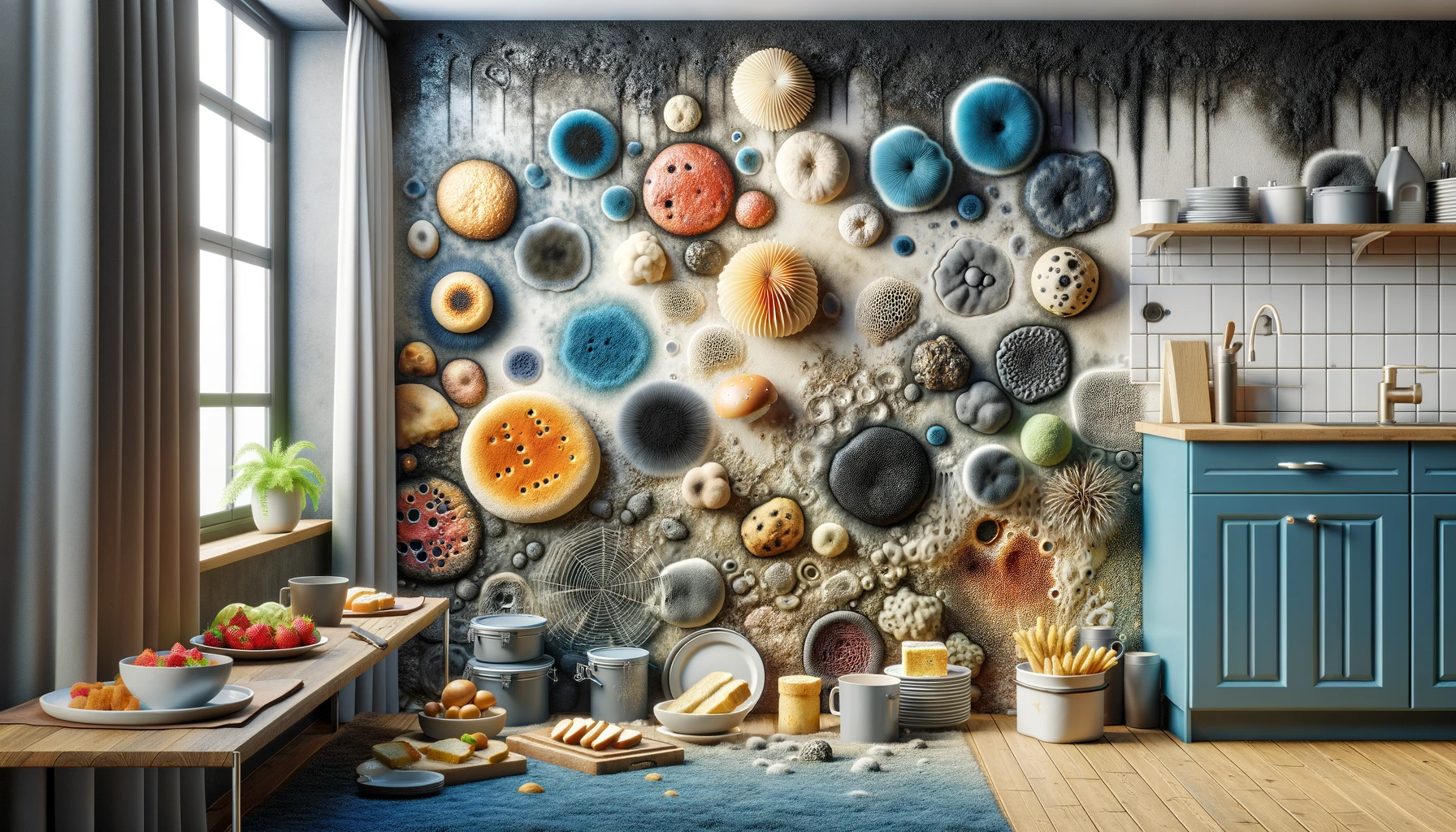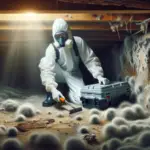Mold is a common household problem, but some kinds of mold can be more dangerous than others. There are many different types of mold species, and some can be particularly dangerous to human health. Toxic molds can cause serious respiratory problems and other health issues, which is why it’s important to understand the various dangerous molds and how to protect your home from them.
This article provides a comprehensive understanding of toxic molds, including their health risks, the most dangerous mold species, and prevention measures you can take to avoid any potential exposure. With this information at hand, you will have the tools necessary to protect yourself from toxic molds in your home.
Mold Spores
Mold spores are tiny particles produced by certain species of mold that can spread throughout the air and settle on damp surfaces, increasing the risk of exposure to dangerous mycotoxins. These mold spores can lead to further growth of molds, which produce additional spores and mycotoxins.
The presence of mold spores in the home or any other indoor environment is a major cause for concern regarding human health, as they can affect respiratory systems and cause serious illnesses if they are inhaled or ingested. Prevention measures such as keeping surfaces clean and free from moisture should be taken to reduce the potential for exposure to hazardous mold spores.
Mold Growth
Mold is a type of fungus that grows in many climate zones and can be found indoors or out. Mold growth is typically characterized by musty odors, as well as the presence of dark spots on walls and other surfaces. It needs moisture to grow and thrives in environments with high humidity levels, like bathrooms or basements.
In these areas, mold grows easily and can spread from surface to surface, making it important to reduce the chance of its growth by keeping dark environments dry and well-ventilated. To prevent mold growth inside your home, make sure to keep windows open regularly and check for any signs of it regularly.
What is Toxic Mold?
With the wide range of mold species out there, some can be exceptionally hazardous to your health. Toxic mold is a term used to describe molds that produce mycotoxins, which are toxic substances. These toxins can be extremely harmful and cause respiratory and neurological issues.
The term ‘toxic mold’ is often associated with one particular species, yet it applies to the almost hundreds of varieties that exist in nature. Black molds are generally considered harmful; however, they might not necessarily be black and can come in various colors. It’s essential to be aware that any form of mold if disregarded for too long, might potentially harm your health.
What Type of Mold is Most Dangerous?
The type of mold that is most dangerous to human health depends on the species and its mycotoxins. Generally, black molds are known to be more hazardous than other types; however, some varieties produce exceptionally poisonous mycotoxins.
Examples include Stachybotrys chartarum or Chaetomium globosum, both of which can cause serious health issues if left unchecked.
When classifying mold, there are three distinct categories: Allergenic, Pathogenic and Toxic.
Allergenic molds are typically harmless but can cause allergic reactions, while Pathogenic molds require medical attention, as they can cause infections in people with weakened immune systems. As for Toxic mold, it is the most dangerous of all and requires extensive preventative measures to be taken.
Most Common Types Of Mold Species
- Stachybotrys – Stachybotrys chartarum, commonly known as black mold, is a dangerous species of mold that produces mycotoxins and can cause serious health problems. It typically grows in moist areas but can be found almost anywhere if given the right conditions. Stachybotrys typically grow on damp materials that contain cellulose, such as cardboard, drywall, ceiling tiles, and wood. Unfortunately, this toxic mold can lead to serious illness in people with weakened immune systems or those who belong to the elderly or young infant population. Therefore, anyone exposed to Stachybotrys must be aware of its potential health risks.
- Fusarium – Fusarium typically appears pink or orange and can be found in carpets, fabrics, and food. While it tends to be less harmful than other types of molds, Fusarium can still cause skin irritation if touched directly. Its spores are also known to produce an offensive odor which can make indoor environments unpleasant.
- Chaetomium – Chaetomium is a toxic mold and can grow indoors and outdoors. It typically appears in shades of gray, white, or tan and produces mycotoxins which can be hazardous to human health if inhaled. This type of mold is often found on wet cellulose materials such as drywall, insulation, and wallpaper.
- Cladosporium – Cladosporium is a prevalent mold that falls into the most dangerous mold category, a black or green mold with a fluffy texture. It usually grows in areas with high humidity, such as bathrooms, basements, and kitchens. Exposure to large amounts of this toxic mold can cause allergic reactions, including sneezing, coughing, and watery eyes. Chronic cases of Cladosporium can produce pulmonary edema and emphysema.
- Aspergillus – Aspergillus species usually appear in shades of green, yellow, and brown. It can be found both indoors and outdoors but is more prevalent in humid areas such as bathrooms, kitchens, and basements. It is an incredibly hazardous species that releases spores into the air, making it especially difficult to breathe in environments contaminated with this toxic household mold. Furthermore, the aspergillus mold family produces carcinogenic toxins like aflatoxins as they originate from strains of both Aspergillus flavus and Aspergillus parasiticus. Individuals who have compromised immune systems are particularly vulnerable to the effects of this mold.
- Penicillium – Penicillium generally appears blue and can be found almost anywhere. It’s commonly found in damp areas such as bathrooms, basements, and attics. Although it is not considered to be toxic itself, it has been known to produce toxins that can cause allergic reactions or respiratory problems when inhaled. Therefore, it is best to avoid exposure and contact with this type of mold.
- Alternaria – Alternaria is a dark green or brown mold that can be found both indoors and outdoors. It’s typically found in areas with high humidity such as bathrooms, kitchens, basements, and even carpets. This type of mold produces potentially hazardous spores which can cause serious health issues when inhaled.
Besides the more common types, there are a few that one may not encounter as often such as Geotrichum, Trichoderma, Memnoniella, Bipolaris, Ulocladium, Aureobasidium and Ascospores or Basidiospores.
However, even these molds have the potential to cause hazardous health issues upon exposure. Therefore, you should take extra precautions to avoid negative repercussions from mold inhalation or contact.
What are the Types of Mold by Color?
Mold can range in color drastically. However, the most common colors are green, white, black, and brown.
- Black Mold – This is the most dangerous and toxic form of mold. It generally appears in shades of black or green with a slimy texture. The most common type is Stachybotrys Chartarum, which produces mycotoxins that can be hazardous to human health when inhaled.
- White Mold – White mold typically appears in shades of white, tan, or gray and usually grows in wet cellulose materials such as drywall, insulation, wallpaper, and wood. Chaetomium is the most common type of white mold, which can produce mycotoxins that can be hazardous to human health when inhaled.
- Green Mold – Is usually found indoors and outdoors and typically appears in shades of green, yellow, and brown. Often part of the aspergilius mold family, which when inhaled, is a harmful mold. Aspergil is the most common type of green mold, which can produce carcinogenic toxins such as aflatoxins.
- Brown Mold – Brown mold usually appears black or dark brown and often grows on organic material such as wood or fabrics. The most common type is Cladosporium, which can produce allergens that can cause allergic reactions upon contact or inhalation.
- Yellow Mold – Also known as slime mold, this vivid yellow hue is produced by certain molds such as Aspergillus, Serpula lacrymans, and Meruliporia. Bright and slimy in appearance, these types of molds create a vibrant atmosphere wherever they appear.
- Orange Mold – These particular species of mold tend to be orange in hue, it has a musty odor and when they start sprouting they form small patches before becoming a slimy orange substance as it matures. Frequently found in moist locations like bathrooms or toilets, these fungi can also appear on wood surfaces and food items such as cheese, yogurt and bread.
- Pink Mold – The pink mold oftentimes seen in bathrooms is caused by Serpula lacrymans, a type of fungi that produces toxins that can be dangerous when inhaled. This species thrives where there’s moisture and is commonly found on wall or ceiling surfaces.
No matter the mold’s color, it’s essential to be aware of its potential to cause hazardous health issues and take necessary measures to avoid any contact with it.
What are the Most Toxic Types of Mold?
The most toxic types of mold are Stachybotrys chartarum (also known as black mold), Fusarium, Chaetomium, and Aspergillus.
All of these can produce dangerous mycotoxins which can cause severe allergic reactions, skin irritation, respiratory problems, and even serious illnesses such as pulmonary edema and emphysema. In addition, these molds can also produce carcinogenic toxins which can be hazardous to human health if inhaled.
It is important to note that even small exposure to mold could lead to serious health complications so it’s best to take preventative measures and avoid contact or inhalation at all costs.
What is Toxic Black Mold?
There is no such thing as “toxic black mold”. It’s a misnomer for the type of mold, Stachybotrys chartarum, also known as black mold. This toxic mold produces called mycotoxins and can cause serious health issues if inhaled or touched. It usually appears in shades of green, black, or gray and has a slimy texture.
What Health Problems Can Mold Exposure Cause?
Mold exposure can cause a variety of health problems, ranging from mild flu-like symptoms to severe respiratory damage and even rare cases of autoimmune diseases. Common illnesses related to being exposed to mold include coughing, wheezing, asthma attacks, allergic reactions and even lung infections in extreme cases.
In addition, those with weakened immune systems are particularly susceptible to serious eye infections, skin rashes and even fungal infections that airborne spores can cause. If you suspect that your home or work environment is contaminated with mold, it is important to take the necessary steps for proper inspection and remediation as soon as possible to protect your health.
How Can I Remove Mold?
Mold removal can be a difficult and often times dangerous task. Understanding the risks and taking the necessary precautions when dealing with mold is important. Mold spores are airborne particulates that may linger in water-damaged materials and find mold on various surfaces, even inside walls.
The most common way of removing mold is to mix bleach with water and apply it to the affected area. When working with bleach, it is important to wear protective gear as the fumes can be hazardous and irritating to breathe in. Make sure you always keep your work area well ventilated and use caution when handling any hazardous materials like bleach.
When dealing with mold, it is important to identify the specific species of mold and determine if it is toxic or harmful. If the mold is found in an area that has experienced water damage, it may be best to seek professional help or contact a certified remediation expert.
Even with careful attention and precautions, some forms of mold can be difficult to remove and can have serious health implications if not taken care of properly.
[/et_pb_text][/et_pb_column][/et_pb_row][/et_pb_section]



